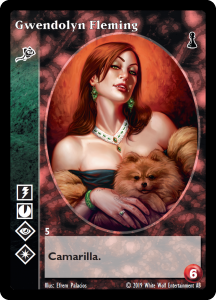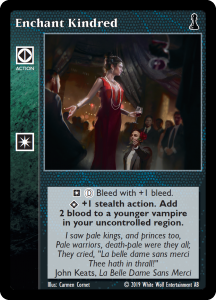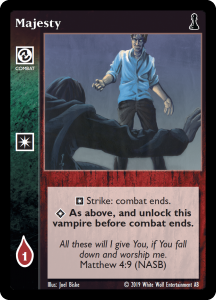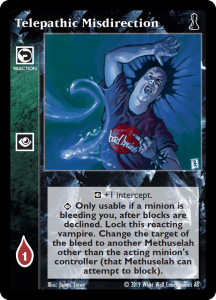
Overview
The First Blood: Toreador introductory deck for Vampire: The Eternal Struggle focuses on destroying your prey’s blood pool through bleeding and political actions, and on the ability to take several actions per turn with the same vampire, if blocked.

In the early game, bring out the highest capacity vampire in your uncontrolled region who has superior Presence, so that, once in play, that vampire can play superior Enchant Kindred to move 2 blood from the blood bank to a younger vampire in your uncontrolled region. So use your transfers wisely so that you can get many vampires out quickly.
Once you have any vampires in play, it is key that you play the master card Aching Beauty on them to dissuade your prey (and to a lesser extent, other Methuselahs) from blocking you.
Then take either your bleed actions (Legal Manipulations or Enchant Kindred) or your vampires’ inherent bleed actions to bleed your prey. If your prey attempts to block, play a Change of Target action modifier or a superior Majesty combat card to unlock and take a different action. If your prey declines to block, play an action modifier that increases the bleed (Aire of Elation).

Another way to cause pool losses to your prey is by means of political actions. Be mindful of how many votes each player has, because you may need the support of a cross-table player to make the referenda of your political actions succeed. Therefore, you may need to benefit that cross-table player somehow in order to get their support.
Your offensive module is strengthened by two cards: The already mentioned Aching Beauty and Scorn of Adonis:
• Aching Beauty: The blocking player burns 1 pool each time a vampire with an Aching Beauty is blocked. Therefore, take as many actions as possible on the same turn with any vampire with an Aching Beauty. Do not put too many Aching Beauty cards on the same vampire.
• Scorn of Adonis: If your prey votes against a political action you called, you can play Scorn of Adonis to have your prey burn 1 pool. This action modifier increases the odds of your referenda passing.
Your defensive angle is not only based on pool gain, but also on blocking key actions as well as on redirecting bleeds to your prey.
Pool can be gained from ousting your prey and from these cards:
• Blood Doll: You can gain 1 pool per turn for each Blood Doll you control.
• Consanguineous Boon: You can gain as much pool as the amount of Toreador vampires you control.
• Art Museum: You can use it to gain 1 pool per turn.
Given this deck’s limited ability to block, you should mainly block political actions that deal pool damage to you, or bleed actions (primarily at 0 stealth) you cannot redirect.
Any blocks should be attempted by unlocked minions. This means that you may have to leave at least one minion unlocked at the end of your turn. Otherwise, use an On the Qui Vive reaction card to attempt to wake and attempt to block and play reaction cards as if unlocked.
Redirecting a bleed to your prey is both a defensive and an offensive move that can be made by playing a Telepathic Misdirection reaction card with an unlocked or waking vampire with superior Auspex to redirect a bleed against you to your prey.

Strategy tips
Normally, whenever a minion controlled by your predator is attempting to bleed you, play a Telepathic Misdirection reaction card with an unlocked or waking vampire with superior Auspex to redirect a bleed against you to your prey.
If being bled by a Malkavian vampire and you have a Telepathic Misdirection in your hand, attempt to block so that they play stealth. Then say you decline to block and allow them to play a bleed action modifier, and afterwards redirect that bleed to your prey.
However, if being bled by a Malkavian vampire and you do not have a Telepathic Misdirection or a vampire who can play it, do not attempt to block, so that they cannot play any stealth cards in hand and get their hand clogged with them.

By default, try to avoid combat. However, when about to enter combat while acting, play Change of Target, particularly against an already locked minion. Whereas, when about to enter combat outside your turn, play Majesty, mainly against Nosferatu, Tremere and Ventrue.
You will rarely have a perfect hand, so good hand management is essential to increase your odds of winning. Therefore, when in doubt, use a discard phase action to discard a card you do not need.
Another factor you should take into account during your minion phase is the order of your actions. Since your resources are limited, have your vampires take the least important actions first and the most important ones last.
And finally, make sure everything you do brings you one step closer to victory. Be patient, and do not let your emotions interfere.

How to build a competitive deck with two First Blood: Toreador decks
Since tournament legal Vampire: The Eternal Struggle decks consist of a minimum of 60 and a maximum of 90 library cards and a minimum of 12 crypt cards, you could combine two First Blood: Toreador decks in order to build a competitive deck meeting both requirements. It could look like this:
Crypt: (12 cards)
2 Epikasta Rigatos
2 Gwendolyn Fleming
2 Kateline Nadasdy
2 Thomas De Lutrius
2 Tyler McGill
2 Vasily
Library: (85 cards)
6 Aching Beauty
1 Art Museum
5 Blood Doll
1 Society Hunting Ground
8 Enchant Kindred
4 Legal Manipulations
4 Consanguineous Boon
8 Kine Resources Contested
5 Aire of Elation
4 Bewitching Oration
8 Change of Target
4 Crocodile’s Tongue
4 Scorn of Adonis
8 Majesty
8 On the Qui Vive
7 Telepathic Misdirection
Good luck playing the First Blood: Toreador deck!
Note: This article can be downloaded with additional graphics in PDF format: How to play the First Blood: Toreador deck
RELATED: How to play the First Blood: Malkavian deck
RELATED: How to play the First Blood: Nosferatu deck
Copyright © 2024 Paradox Interactive AB. www.paradoxinteractive.com. All rights reserved. Vampire: The Eternal Struggle and Vampire: The Masquerade® are trademarks and/or registered trademarks of Paradox Interactive AB. All rights reserved.

